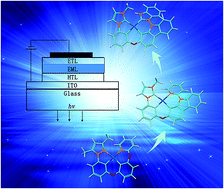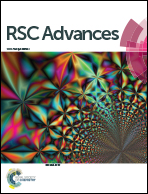Theoretical study and design of highly efficient platinum(ii) complexes bearing tetradentate ligands for OLED†
Abstract
Density functional theory and time-dependent density functional theory investigations were performed on the geometrical structures, basic photophysical properties, phosphorescence quantum efficiency (Φ PL), and reorganization energy (λ) calculations of a new potential class of tetradentate Pt(II) complexes Pt[ppz-O-Popy] (1) (where ppz = phenyl-pyrazole; Popy = phenoxyl-pyridine), Pt[pmi-O-Popy] (2) (where pmi = phenyl-methylimidazole), Pt[pmi-O-Cbpy] (3) (where Cbpy = carbazolyl-pyridine) and Pt[ppz-O-Cbpy] (4), which show highly efficient (ΦPL > 80%) and deep-blue emission. Nonradiative decay processes were investigated in order to obtain a more reliable nonradiative decay rate comparison. The calculated results confirm that tetradentate Pt(II) complexes are conducive to maintaining the rigidity of the molecules. The extended conjugation complexes with carbazole groups in 3 and 4 can not only improve the structural rigidity but also enhance the capability and balance of charge transfer. Thereupon, the following two designed derivatives Pt[pmi-O-Cbmi] (5) and Pt[pmi-O-Cbbm] (6) which substitute pyridine with imidazole and benzimidazole based on complexes 3 and 4 are also considered for promising materials exploitation and theoretical understanding. The charge transfer balance performance and the radiative decay rate constant (kr) of 5 and 6 are greatly improved compared with 1–4, and the better structural rigidity will weaken nonradiative decay pathways, which may result in a higher phosphorescence quantum efficiency. Therefore, complexes 5 and 6 through judicious molecular design will be promising candidates as highly efficient blue-emitting phosphorescent materials for applications.

- This article is part of the themed collection: Luminescence and photophysical properties of metal complexes

 Please wait while we load your content...
Please wait while we load your content...